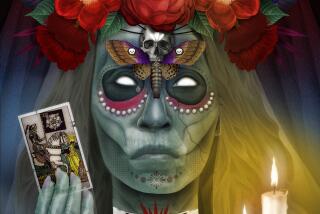San Clemente Writer’s Voyage Through 1492 : Mary Ann Whittier blends fact and fiction in a study of the people and events anchored in the year Columbus sailed to the New World.
- Share via
Every school kid knows what happened in 1492, but what else was going on around the world when Christopher Columbus made his epic voyage?
That’s the premise behind Mary Ann Whittier’s “Tales From 1492,” a blend of fact and fiction in which the San Clemente author examines the people, places and events of that fateful year.
It was, as Whittier points out, a time when chamber pots were emptied in the streets of Europe and great flocks of parrots still filled the skies over Cuba. And it also was a time in which familiar figures such as Michelangelo, Martin Luther, Lucretia Borgia, Nicolaus Copernicus and Montezuma were alive.
Written in a month-to-month format, “Tales From 1492” (Trillium Press; $25 in hardcover; $12.99 in paperback) weaves historical and fictional characters going about their daily lives 500 years ago as Columbus makes his voyage to the New World.
Deep in equatorial Africa, for example, the ruler of more than 1 million people in the Congo has embraced Christianity and is dealing with pressures to change his polygamous lifestyle and the social order of his kingdom. In Poland, meanwhile, a Mass is being said for Casimer IV, King of Poland and Lithuania, whose body is resting in a coffin in front of the Cathedral of Our Lady at Krakow.
The idea for “Tales From 1492” came to Whittier in 1985 when she was confined to bed while recuperating from a broken leg.
“I was looking at a weekly planner our stockbroker gave us and it really did just come to me as a kind of inspiration,” recalled Whittier, who had been intrigued with 1492 since she and her husband, Robert, were in Granada a few years earlier “and our daughters had rung the same bell that had been rung in 1492 to celebrate the defeat of the Moors in Spain.”
Whittier, who teaches a course in art history at Saddleback College, was also aware that Lorenzo de’ Medici, the Italian Renaissance arts patron, had died in 1492, “leaving his young apprentice Michelangelo stranded.”
“And so,” she said, “those things were in my mind and while lying in bed I thought, ‘What else happened in 1492?’ ”
She began her research at the San Clemente Library, but “just to give the book balance and scope and a global theme I had to go looking for stuff.” During five years of on-and-off research, she examined books, letters and other historical documents at Stanford University and at the Huntington Library in San Marino.
Along the way, she discovered that there was actually a Christian church in the Congo in 1492 and that same year the traitorous brother of the ruler of the Ottomon Empire was a hostage of the Pope. (He is also believed to have been the model for the turbaned Turk in a fresco in the Vatican.)
The book, Whittier said, “is global in scope. It’s got a touch of everything, including Australian aborigines. In this book I try to hit holidays, religious observances in different countries and major deaths and things. And because of my art history background, I have a fair amount of artists and craftsmen in there.”
In writing the various episodes in the book, Whittier said, “I wanted to make them entertaining but factual. I’m getting a good response from schools. They say this makes students interested in history. It’s got a little more zip to it.”
Although her publisher generally sells books to schools and libraries, Whittier said “Tales From 1492” is available at the Book Site in San Clemente, Fahrenheit 451 in Laguna Beach, Room With a View in San Juan Capistrano and Teaching World & Toys in Laguna Niguel.
Whittier is now working on a sequel dealing with the year 1795, “a year in which Catherine the Great is almost ready to die and Napoleon is just a young upstart.”
“It’s a great year for the first laws against slavery,” she said, adding that “Tales From 1492” “is more about the humanism of the Renaissance and the age of exploration. The second book is more about people thinking about everybody, the rights of individuals after the American and the French Revolution.”
More to Read
Sign up for our Book Club newsletter
Get the latest news, events and more from the Los Angeles Times Book Club, and help us get L.A. reading and talking.
You may occasionally receive promotional content from the Los Angeles Times.









